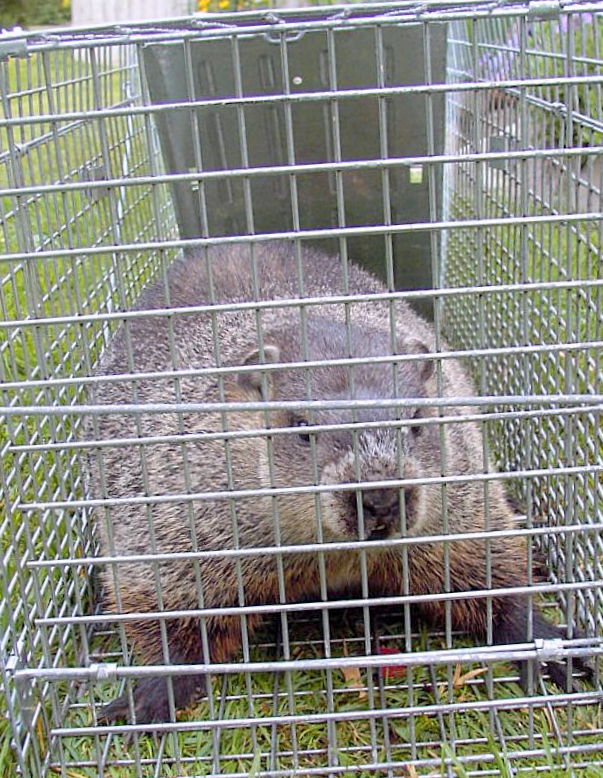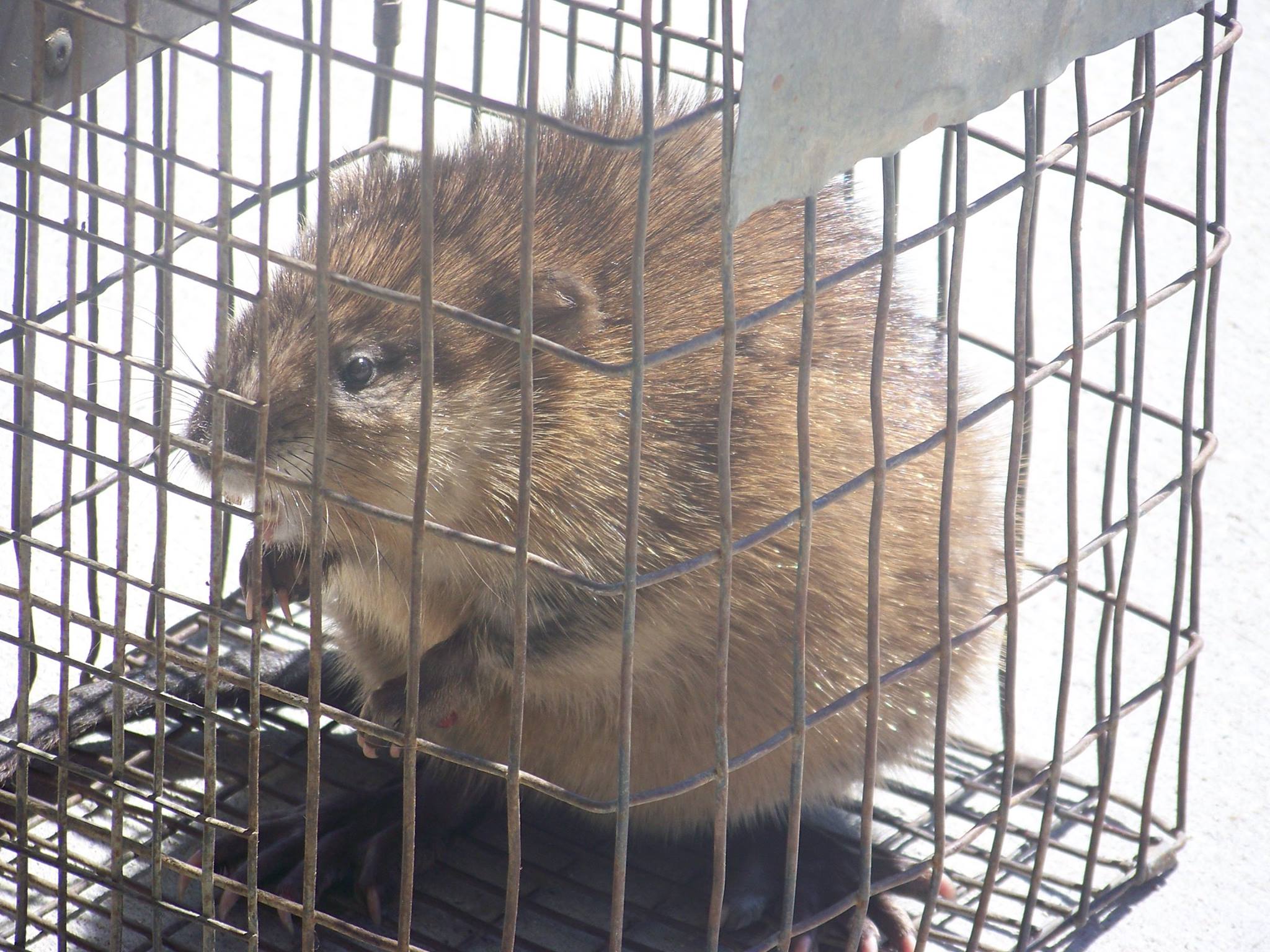Groundhog Removal

Groundhog Removal
Groundhogs can be found all over the United States, and they are beginning to become more prevalent in urban areas as urban sprawl increases. While they seem completely harmless, these tunneling critters can leave you with some very serious bills to pay in the long run. Continue reading to learn more about the groundhog and how you can remove them from your property.

What damage do groundhogs cause?
These burrowing critters do mostly all of their damage without thinking twice about it. The majority of the damage groundhogs cause is because of their tunneling behavior. Groundhogs dig large tunnels with multiple openings and a large den, so they can escape from threats in many different directions. The problem with this is that groundhogs often decide to burrow right next to homes, buildings, and other structures. While it is not that big of a deal in a short time span, in the long run, this can cause serious weakening of the foundations of your homes and buildings. This can eventually cause a foundation collapse which will cost a lot of money to repair. In addition to their tunneling, groundhogs also tear up flower beds and will eat many plants you have out, whether they are decorative or a vegetable or a fruit.
How can I prevent groundhogs?
When you are trying to prevent groundhogs, it might feel like a fairly difficult task, since they can burrow under fences. If you are really determined to keep groundhogs out, you can install an underground and aboveground fence that prevents access entirely. If this sounds like too big of an expense, consider just reducing your yard’s appeal to nuisance animals by taking some simple steps. First, be sure that your pet food and any garbage are secured and that no animals can access them. Then pick up any fallen fruit or vegetables you have around your yard. Finally, simply reducing the clutter and debris in your yard can discourage groundhogs and other nuisance animals from coming onto your property.
How can I catch groundhogs?
While removing groundhogs seems like it should be a pretty simple process, it often turns out that it is not. In theory, simply setting a cage trap with bait in it next to the entrance to the burrow should be able to catch a majority of the groundhogs inhabiting your property. More often than not, the groundhogs will not be caught by the trap, as they get wise to it quickly. This can present some unique challenges that most homeowners end up not being able to solve entirely. This is why it is usually recommended to have a professional wildlife removal company remove the groundhogs for you.
Why hire New Jersey Wildlife & Pest Control?
Here at New Jersey Wildlife & Pest Control, our experts have years of experience in dealing with all of New Jersey’s most common nuisance wildlife, and groundhogs are no exception. When you cannot seem to get rid of groundhogs, it is a great idea to call us at New Jersey Wildlife & Pest Control, as we will help you solve your pest control problems as soon as possible. We treat our clients with the utmost ethics and respect, and we are proud to deliver excellent results at the lowest price possible.

How to Keep Groundhog Out Of The Yard
A lush green yard or vegetable garden is often the perfect home for groundhogs. This burrowing mammal with a voracious appetite has a taste for green vegetables and fruits. Groundhogs are herbivores and are known to eat up to 1⅕ pounds of vegetation each day.
They love to burrow and will make themselves comfortable in your yard by tunneling into the ground and eating as many plants as they can get into their mouth. With a large appetite for plants and shovel-like claws designed for digging, there is no telling the amount of damage a group of woodchucks can cause to your yard. Visit groundhogtrapping.com to learn more about how to trap groundhogs.
And if these animals have found their way to your property, then you have to kick them out using the following 4 tips.
- Keep your lawn neat
One quick way to attract all sorts of unpleasant animals to your property is by keeping grasses overgrown and leaving piles of dead and decaying leaves. Animals love the shed and cover this provides and will visit a couple of times before moving in to make their home there.
However, a tidy lawn with properly trimmed grasses with no piles of brush or dead leaves will certainly be unattractive to groundhogs, rodents, and nuisance animals in general. Keeping your lawn may not magically do the trick, but will go a long way in preventing animal pests.
- Try Repelling Them
Groundhogs are sensitive to certain smells, and they particularly despise the smell of pepper and garlic. You can use this knowledge to your advantage by converting garlic and pepper as a type of weapon against groundhogs. To do this, you may need to make a garlic and pepper spray that will be sprayed around their favorite entrance spots and on plants and vegetables they like to attack.
An effective method for repelling groundhog in the garden or lawn is by mixing ground pepper and garlic, and thoroughly scattering the mixture around strategic areas, paying more attention to the entire perimeters of your property. The strong smell of this mixture should be enough to keep these burrowing mammals away.
Another viable option for repelling groundhogs is planting lavender flowers around your lawn. The lavender plant can be used to create a hedge around your lawn, and while it has a sweet fragrance, woodchucks find it offensive and tend to stay away from them.
- Consider A Wire Fence
Another option for keeping destructive groundhogs away from your property is by blocking them out. These animals are small, and you can block them by erecting a small fence around your lawn or garden. A wire fence of at least 3 feet tall and about 12 inches into the ground is perfect for preventing groundhogs from causing any form of destruction in your garden, it can also work for your lawn.
And that’s if you don’t mind having a wire fence around your lawn. If this isn’t a solution you’re willing to consider, then try installing a motion-sensitive sprinkler that will blast any animal that comes into your lawn with a harsh stream of water. Since groundhogs tend to be very nervous creatures, an unpleasant stream of water will often scare them away.
- Trap them alive
This is certainly the most difficult method and should only be considered if all the other solutions do not yield favorable results. Trapping and removing groundhogs from your property is certainly not going to be easy, and you may have to call in the experts for it. However, if you would like to give it a try, then you should first get yourself a good trap from your hardware store.
You will need to carefully examine your lawn or garden in search of visible groundhog burrows. Remember that these animals like to conceal their burrow with dry and decaying leaves, find all the burrows you can, and seal them off, leaving just one open. Then, proceed to set the trap about 5 feet away from the open groundhog tunnel. If you are unable to find and close all the burrows, you can simply set the trap in an area where the groundhog frequents.
To lure the marmot into the trap, you will need a suitable bait, which can either be corn, sunflower seeds, peanut butter, or cantaloupe rind. Some fruits and veggies like apples, berries, carrots, and lettuce also work. When the trap is set, try to conceal it with some grasses, leaves, and rocks, this way the animal will be less cautious of it and more likely to walk in for a bite.
Leave it to the professionals
Trapping and removing animal pests can be a very tricky business, not to mention a long list of risks and dangers involved. Animals are not very easy to control and some can be very erratic. Worst off, if animal trapping goes wrong, the consequences may be severe.
This is why we always recommend that you leave it to the pros. Our experts at New Jersey Wildlife & Pest Control are dedicated towards solving all your animal problems. Call us today for quick and efficient groundhog removal.
How to Trap a Groundhog
Groundhogs are smarter than you think, usually because they are susceptible to external changes or predators. Without traps, it can be tough to deal with Groundhogs, except you poison their food source (which is inhumane and considered an offense in many places).
If you have a groundhog problem, your best bet is to trap the animal using a Live Cage. However, this is not as simple as it is read or written. It requires skill, craftiness, patience, and lots of planning. Since most people don’t have to do all these, they contact our professional services to rid them of the menace of Groundhogs.
These steps will help you effectively track, trap, and relocate a Groundhog, including;
- Inspect the areas
Groundhogs dig very impressive burrows. Many refer to them as kings of the underground. If you see other smaller animals hiding inside the holes, know a groundhog probably dug it. Their burrow linkage and length can stretch for miles.
Sometimes, the cause of your plant death/decay may not be Groundhog, and that is why you must inspect first. Some of the tell-tale signs of groundhog infestation include;
- Finding entry parts to holes frequently around your garden,
- Damage to crops, especially through eaten stems, seeds, or roots
- Teeth marks on woods, plants, and small piles of soil (newly dug)
- Trapping the Groundhogs
Choosing a good trap is the most important part of trapping a Groundhog. A good trap should be sturdy, smooth, and inescapable for the animal. It will be a defeat for the groundhog to chew their way from the trap after being shut in.
You can either visit the local wildlife stores or contact our professional services to take the best steps for trapping them.
Where do you place a Groundhog trap?
This is where you apply some of the information/insight you got during the inspection. The trap should be installed within 5-10 feet from the entrance. Since groundhogs rarely stray from their burrows, situate the trap as close to the entrance without looking imposing or obstructing.
However, you can also install the trap in the area where the Groundhog impact/destruction is well felt in the garden/property. The trap should also be on an even and level surface to ensure stability.
- Hide your trap using decoys
Groundhogs don’t like new installations, especially when they smell human contacts. The shiny or rigid nature of the cage may spook the animal. A simple solution is to hide the cage to blend with the surroundings. You can wrap some crawling twigs or bushes around the traps.
You can also leave the cage covered in grass, leaving the entry open and ordinary. Spray mud, dirt, or other dirt around the trap to give it a befitting blend.
- Include an irresistible bait
It is hard to catch a raccoon unless you present some of its favorite food. The trap can be baited with almost anything, especially plants that it steals from your garden. Also, you should position the bait properly in the cage so that the door closes without obstruction.
- Watch your trap
It is essential to watch the trap within respectable intervals. It is inhumane to leave a trapped animal without food and water. It may even make the Groundhog victim of other predators like snakes or other vicious wanderers.
After removing the Raccoon, you should resettle it in a distant area from your garden. However, you may contact animal services for the next steps.
- Avoid Poisons
Regardless of the destruction Groundhogs cause, it is inhumane (and prohibited in certain regions) to use Poison against wildlife. Where the process becomes complicated, contact our professional services.
